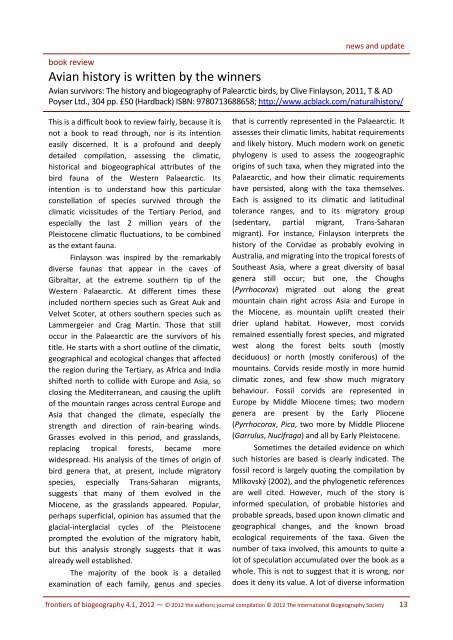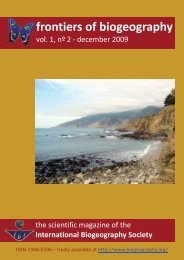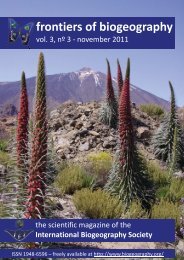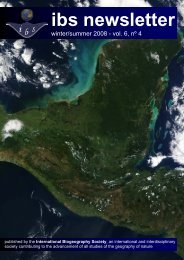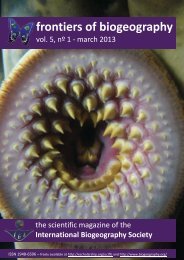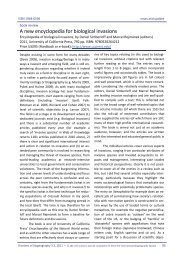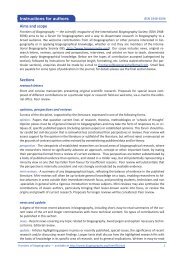1 - The International Biogeography Society
1 - The International Biogeography Society
1 - The International Biogeography Society
- No tags were found...
You also want an ePaper? Increase the reach of your titles
YUMPU automatically turns print PDFs into web optimized ePapers that Google loves.
news and updatebook reviewAvian history is written by the winnersAvian survivors: <strong>The</strong> history and biogeography of Palearctic birds, by Clive Finlayson, 2011, T & ADPoyser Ltd., 304 pp. £50 (Hardback) ISBN: 9780713688658; http://www.acblack.com/naturalhistory/This is a difficult book to review fairly, because it isnot a book to read through, nor is its intentioneasily discerned. It is a profound and deeplydetailed compilation, assessing the climatic,historical and biogeographical attributes of thebird fauna of the Western Palaearctic. Itsintention is to understand how this particularconstellation of species survived through theclimatic vicissitudes of the Tertiary Period, andespecially the last 2 million years of thePleistocene climatic fluctuations, to be combinedas the extant fauna.Finlayson was inspired by the remarkablydiverse faunas that appear in the caves ofGibraltar, at the extreme southern tip of theWestern Palaearctic. At different times theseincluded northern species such as Great Auk andVelvet Scoter, at others southern species such asLammergeier and Crag Martin. Those that stilloccur in the Palaearctic are the survivors of histitle. He starts with a short outline of the climatic,geographical and ecological changes that affectedthe region during the Tertiary, as Africa and Indiashifted north to collide with Europe and Asia, soclosing the Mediterranean, and causing the upliftof the mountain ranges across central Europe andAsia that changed the climate, especially thestrength and direction of rain-bearing winds.Grasses evolved in this period, and grasslands,replacing tropical forests, became morewidespread. His analysis of the times of origin ofbird genera that, at present, include migratoryspecies, especially Trans-Saharan migrants,suggests that many of them evolved in theMiocene, as the grasslands appeared. Popular,perhaps superficial, opinion has assumed that theglacial-interglacial cycles of the Pleistoceneprompted the evolution of the migratory habit,but this analysis strongly suggests that it wasalready well established.<strong>The</strong> majority of the book is a detailedexamination of each family, genus and speciesthat is currently represented in the Palaearctic. Itassesses their climatic limits, habitat requirementsand likely history. Much modern work on geneticphylogeny is used to assess the zoogeographicorigins of such taxa, when they migrated into thePalaearctic, and how their climatic requirementshave persisted, along with the taxa themselves.Each is assigned to its climatic and latitudinaltolerance ranges, and to its migratory group(sedentary, partial migrant, Trans-Saharanmigrant). For instance, Finlayson interprets thehistory of the Corvidae as probably evolving inAustralia, and migrating into the tropical forests ofSoutheast Asia, where a great diversity of basalgenera still occur; but one, the Choughs(Pyrrhocorax) migrated out along the greatmountain chain right across Asia and Europe inthe Miocene, as mountain uplift created theirdrier upland habitat. However, most corvidsremained essentially forest species, and migratedwest along the forest belts south (mostlydeciduous) or north (mostly coniferous) of themountains. Corvids reside mostly in more humidclimatic zones, and few show much migratorybehaviour. Fossil corvids are represented inEurope by Middle Miocene times; two moderngenera are present by the Early Pliocene(Pyrrhocorax, Pica, two more by Middle Pliocene(Garrulus, Nucifraga) and all by Early Pleistocene.Sometimes the detailed evidence on whichsuch histories are based is clearly indicated. <strong>The</strong>fossil record is largely quoting the compilation byMlíkovský (2002), and the phylogenetic referencesare well cited. However, much of the story isinformed speculation, of probable histories andprobable spreads, based upon known climatic andgeographical changes, and the known broadecological requirements of the taxa. Given thenumber of taxa involved, this amounts to quite alot of speculation accumulated over the book as awhole. This is not to suggest that it is wrong, nordoes it deny its value. A lot of diverse informationfrontiers of biogeography 4.1, 2012 — © 2012 the authors; journal compilation © 2012 <strong>The</strong> <strong>International</strong> <strong>Biogeography</strong> <strong>Society</strong>13


